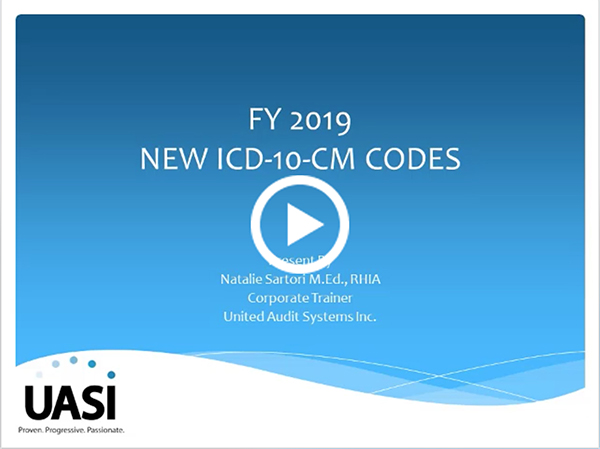Coding Tip of the Month – September 2018
New ECMO Procedural Codes Extracorporeal membrane oxygenation (ECMO), also known as extracorporeal life support (ECLS), is an extracorporeal technique of providing prolonged cardiac and respiratory support to persons whose heart and lungs are unable to provide an adequate amount of gas exchange or perfusion to sustain life. The technology for ECMO is largely derived from…
UASI Training for FY2019 ICD-10-PCS Updates
The annual updates to the ICD-10 and MS-DRG systems have been finalized and will be effective October 1. The ICD-10 and MS-DRG updates reflect the final Hospital Inpatient Prospective Payment System (IPPS) rule for the fiscal year 2019, published by CMS on August 6. You can see the details on IPPS here. Other highlights of…
UASI Training for FY2019 ICD-10-CM Updates
The annual updates to the ICD-10 and MS-DRG systems have been finalized and will be effective October 1. The ICD-10 and MS-DRG updates reflect the final Hospital Inpatient Prospective Payment System (IPPS) rule for fiscal year 2019, published by CMS on August 6. You can see the details on IPPS here. Other highlights of the…
Constant Change Requires Ongoing Education: How UASI Delivers Continuous Learning
Continuous learning is the only way to keep up with shifting standards and guidelines, payment reform, and the latest changes in healthcare technology. Accurate, high-quality coding is simply not possible without ongoing education.
Annual Code Updates Are Here – And So Is UASI Training
Continuous learning is the only way to keep up with shifting standards and guidelines, payment reform, and the latest changes in healthcare technology. Accurate, high-quality coding is simply not possible without ongoing education.
Coding Tip of the Month – August 2018
FY 2019 ICD-10-PCS Updates It is time once again to prepare for the annual code updates. The table below summarizes the October 1st, 2018 updates for both CM and PCS. New Codes Deleted Codes Revised Codes ICD-10-CM 247 49 139 ICD-10-PCS 392 216 8 The synopsis below highlights just some of the PCS changes for…
Coding Tip of the Month – July 2018
Guideline I.A.15 “With” The FY 2017 updates introduced a major change to Guideline I.A.15 “With” as depicted in bold print below: The word “with” should be interpreted to mean “associated with” or “due to” when it appears in a code title, the Alphabetic Index, or an instructional note in the Tabular List. The classification…
Coding Tip of the Month – June 2018
When coding a patient with DM and peripheral angiopathy, peripheral vascular disease or peripheral arterial disease, assume a link between the two conditions unless the provider has linked the peripheral angiopathy to another underlying condition. Because atherosclerosis is a speciic type of peripheral angiopathy use an additional code from I70.2- through I70.7- if the angiopathy is further…
Coding Tip of the Month – May 2018
Spinal Fusion vs. Spinal Stabilization The First Q 2018 (P. 22) Coding Clinic provided clarification that stated spinal fusion procedures without bone graft cannot be coded to the root operation “Fusion”. The rationale for this advice is that while the root operation of “fusion” does not require the use of bone graft, the spinal fusion…
Coding Tip of the Month – April 2018
When coding a patient with DM and peripheral angiopathy, peripheral vascular disease or peripheral arterial disease assume a link between the two conditions unless the provider has linked the peripheral angiopathy to another underlying condition. Because atherosclerosis is a specific type of peripheral angiopathy use an additional code from I70.2- thru I70.7- if the angiopathy…
Coding Tip of the Month – March 2018
Scenario: During a screening colonoscopy, a rectal polyp was found and removed via hot snare. The pathological findings revealed “hyperplastic polyp with focal adenomatous changes.” What code is assigned for the polyp? Should code K62.1, Rectal polyp, or code D12.8, Benign neoplasm of rectum, be assigned for a hyperplastic rectal polyp with focal adenomatous changes? Answer:…
Coding Tip of the Month – February 2018
Hemodialysis Duration Three new duration values were added to code table 5A1, Physiological Systems, Performance, to capture the duration and continuity of hemodialysis procedures: 7 Intermittent – Less than 6 hours per day 8 Prolonged Intermittent – 6 – 18 hours per day 9 Continuous – Greater than 18 hours per day These new values…

